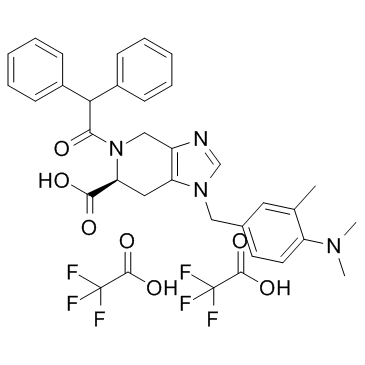Biochemical characterization of two distinct angiotensin AT2 receptor populations in murine neuroblastoma N1E-115 cells.
I R Siemens, L P Reagan, D K Yee, S J Fluharty
Index: J. Neurochem. 62 , 2106-2115, (1994)
Full Text: HTML
Abstract
The murine neuroblastoma N1E-115 cell line possesses a high density of angiotensin II (AngII) receptors that can be solubilized with the zwitterionic detergent 3-[(3-cholamidopropyl)dimethylammonio]-1-propanesulfonate. These solubilized binding sites exhibited high affinity for CGP-42112A and not Losartan, indicating that they were of the AT2 subtype. However, displacement of 125I-AngII with the AT2 nonpeptide antagonist PD-123319 resulted in a biphasic curve, suggesting heterogeneity of the AT2 receptor population in N1E-115 cells. In support of this view, separation of two receptor populations was accomplished with heparin-Sepharose chromatography. More specifically, three distinct protein peaks eluted from the heparin-Sepharose column, two of which bound 125I-AngII with high affinity and saturability. One of these binding peaks (peak I) eluted rapidly and represented approximately 80% of the total binding activity, whereas the remaining binding activity was contained within a second peak (peak III) that required the addition of 1.5 M NaCl for its complete elution. Pharmacological analysis revealed that both peaks of binding activity were exclusively AT2 receptors insofar as they exhibited high affinity for CGP-42112A and little or no affinity for the AT1-selective antagonist Losartan. However, whereas the nonpeptidic AT2-selective antagonist PD-123319 completely displaced the binding of 125I-AngII from peak I in a monophasic fashion (IC50 = 9.1 +/- 4.1 nM; mean +/- SEM; n = 3), PD-123319 was much less effective in displacing 125I-AngII from peak III (IC50 = 196 +/- 27 nM; mean +/- SEM; n = 3). Treatment of individual peaks with the reducing agent dithiothreitol caused a large increase in 125I-AngII specific binding in peak III, whereas a decrease in binding was observed in peak I. Moreover, GTP gamma S significantly reduced high-affinity agonist binding in peak I but not peak III, further suggesting heterogeneity in the AT2 receptor family. Finally, immunoblotting studies with polyclonal antisera raised against peak I specifically detected two proteins of 110 and 66 kDa, as is true in crude solubilized membranes, whereas no immunospecific proteins were detected in peak III. These same antisera immunoprecipitated 125I-AngII binding activity in peak I but were ineffective in peak III. Collectively, these results suggest that heparin-Sepharose chromatography can efficiently separate two pharmacologically, biochemically and immunologically distinct populations of AT2 receptors.
Related Compounds
| Structure | Name/CAS No. | Molecular Formula | Articles |
|---|---|---|---|
 |
PD123319 di(trifluoroacetate)
CAS:136676-91-0 |
C35H34F6N4O7 |
|
Contractility of placental vascular smooth muscle cells in r...
2008-06-01 [Placenta 29(6) , 503-9, (2008)] |
|
Modulation of angiotensin II binding affinity by allosteric ...
1992-04-01 [Mol. Pharmacol. 41 , 809-815, (1992)] |
|
Differential blockade of central effects of angiotensin II b...
1993-07-01 [Am. J. Physiol. 265 , H226, (1993)] |
|
Developmental effect of antenatal exposure to betamethasone ...
2010-04-01 [Am. J. Physiol. Regul. Integr. Comp. Physiol. 298 , F847-F856, (2010)] |